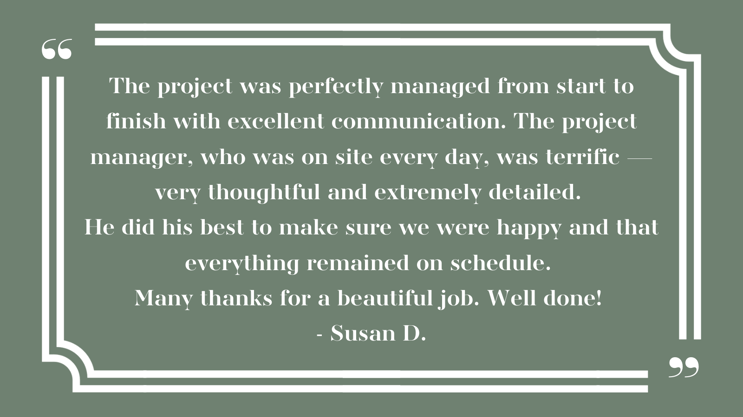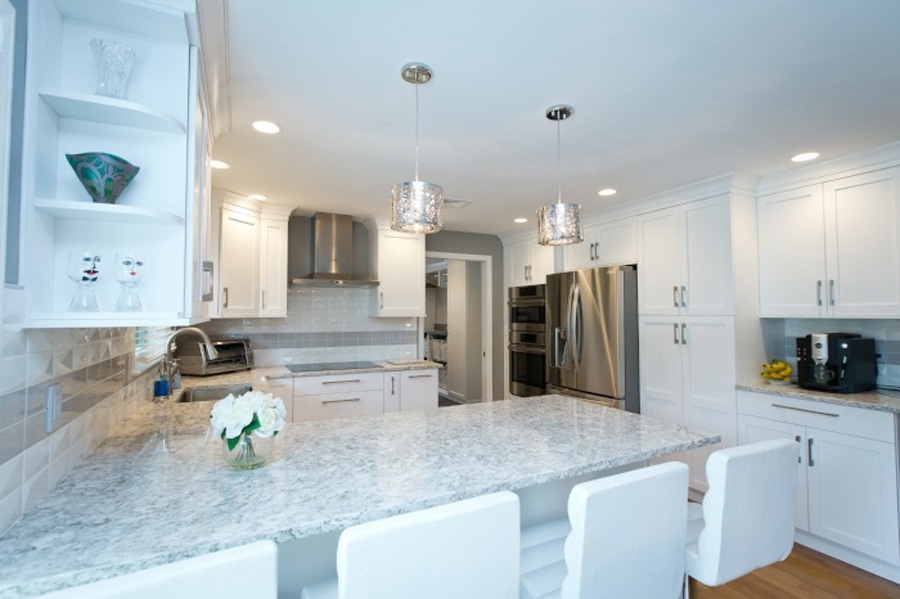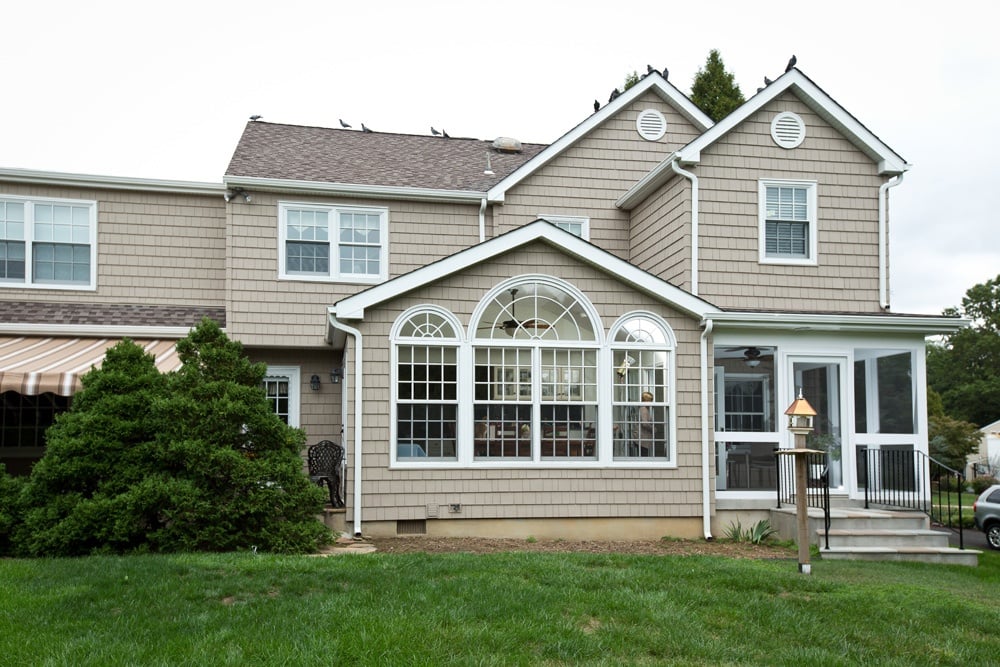Preparation is Key: Issues to Consider and How to Plan for What’s Ahead
Dust Control and Indoor Air Quality
Perhaps the most common frustration with a major remodel is the resulting dust and its impact on indoor air quality. The amount of dust and other particles in the air during construction far exceeds what is in the home during normal circumstances. If not managed properly, dust will reach every corner of your home—beyond countertops and floors to glassware, kitchen utensils, bed linens, and even your toothbrush. Major remodels can stir up other materials and debris such as dead bugs, mold, mildew, and lead in particles small enough that, once ingested, can reach deep into your lungs or bloodstream.
While the mess is frustrating, this “dust storm” can also pose significant health concerns, particularly for those who suffer from asthma, allergies, heart conditions, or other chronic diseases. For homeowners with respiratory issues, we recommend they stay out of the house during the day while we’re working. Ask your contractor how they plan to combat the problem before construction begins. Are there new tools and processes available for capturing excess dust? Be sure to communicate your concerns.
While dust is inevitable, there are steps you can take to minimize the spread, and these are practices we employ.
- Keep rooms not part of the remodel closed off, and stuff towels under the door to reduce the encroachment of dust to other areas.
- Hang plastic and drop cloths in open entryways, and create a designated walkway for contractors to and from the project area and the front door and bathroom. The Tilghman team puts up plastic walls to section off the construction area to control dust, and zippers enable homeowners to walk in and out of the area.
- Install fans in windows for proper ventilation. We run a HEPA Air Filtration System on all of our projects, collecting fine particulates.
- Remove wall art and smaller furniture, and cover heavier furniture with a drop cloth.
- Create a daily cleaning routine, including vacuuming, sweeping floors, and wiping down surfaces.
Managing Clutter
Reducing the clutter in your home prior to a remodel will help protect your possessions from dust and breakage and reduce the stress of having your home in disarray. Before work begins, sort through and declutter the area to be remodeled. Pack away frequently used items in clear storage containers to protect them from dust and workers, while still being accessible. Pack less used items in clearly-labeled cardboard boxes and store in another area of the house or a storage unit. Also, contemplate your needs for the new space and communicate any layout or storage requirements to your designer or architect.
During the remodel, take steps to keep the chaos under control. Designate one spot in the house for project deliveries and supplies, and designate “clean zones,” such as the kitchen counter and the bedrooms, for daily removal of clutter. Taking the time to “restore order” to these spots will help the entire home feel tidier and help save your sanity as well. When the remodel is complete, you may find you no longer need those things you packed away. Consider what items you could part with in order to enjoy your newly remodeled space, uncluttered!
Security
Even with the most trustworthy contractor, your home is vulnerable to theft with a number of workers moving in and out. You should secure personal items that are easy targets, such as cash, jewelry, and small electronic devices. Never leave construction items of high value unsecured, such as tools, copper wire and pipes, brass fixtures and plumbing fittings, aluminum siding and metal roofing, or appliances and other high-end materials. Copper in particular is a prime target for thieves who take it to recycling centers in exchange for cash.
In addition to protecting your valuables, think about the overall security of your home. When building an addition, ask your contractor about the transition period while of parts of your home may be open without secure doors. For the Tilghman team, if we are building an addition to the house, we always build the addition first and install windows/doors before opening the entryway to the existing home, so your home stays secure.
Consider video monitoring that will allow you to check on areas of the home via smartphone or web browser when you can’t be present. Also, keep neighbors informed. Let them know the names of the companies you have hired and what days you expect work to take place.
Last but not least, know your contractor. Do some research on the reputation of those who will be doing work in your home by reading online reviews and requesting referrals. Once the project is complete, consider changing your locks if you previously provided contractors with keys. These steps protect your valuables and offer you peace of mind during the process.
Noise
Noise is an inevitable byproduct of almost any home renovation, but it can be a real headache. First and foremost, read your HOA rules. Many communities have regulations in place as to what types of work can be performed and during what hours construction can commence. Be sure to share this information with your contractor. Try keeping the same schedule as your contractor so that you are not awakened by the sound of heavy machinery. If you work from home, use noise-canceling headphones and consider moving your workspace to the other end of the house.
Neighbors
Be mindful that neighbors are also affected by your remodeling project. Warn them before your construction starts. Giving them a heads-up shows you’re considerate of their feelings and will ensure they aren’t caught off guard by added traffic, the appearance of dumpsters and port-a-potties, and the sounds of nail guns and table saws. Communicate details such as when dumpsters are to be picked up, changes to your deadline, and when large deliveries are expected. You may ask that they contact you if noise or debris does get out of hand. Being proactive will hopefully engender goodwill with your neighbors and help avoid any issues in your neighborhood. Finally, when the work is done, invite them over to help you celebrate and show the finished product!
Questions to Ask Prospective Contractors
In addition to conducting your own research, discuss livable remodeling concerns with prospective contractors, as they are the industry experts. Here are a number of questions to get you started:
Lean on their experience: How can I prepare for a livable home remodel?
Timeline: At what point during the remodel will noise be the loudest?
Safety: Do you have any specific safety tips to consider? Should I invest in an air filter or use masks? Can any chemicals potentially cause harm to my children or pets? Are there any common allergies or sensitivities I should be aware of?
Security: How can I best secure the premises and materials?
Cleaning: How involved is your crew when it comes to cleaning throughout the remodel and after? How can I best contribute?
Best Practices: Tilghman’s Approach to Livable Remodeling
Tilghman Builders has been renovating homes and transforming spaces for Pennsylvania families in Bucks and Montgomery counties for more than 40 years. We are experts in livable remodeling—it’s our “thing”! Every client/family is different, so it’s important that we adapt to their everyday life. We avoid being a hindrance to our clients.
Here’s how we address typical livable remodeling concerns:
Dust
- We put up plastic walls to section off the construction area to control dust. Zippers enable homeowners to walk in and out of the area.
- We install fans in windows for proper ventilation.
- For homeowners with respiratory issues, we recommend they stay out of the house during the day while we’re working.
-
We run a HEPA Air Filtration System on all of our projects, collecting fine particulates.
Managing Clutter
- We remove construction debris immediately. We don’t leave trash lying around. Once we demolish, we clean up the mess so homeowners don’t have to worry about a build-up of clutter.
- We also make sure our materials are organized, which makes us more efficient.
Security
- If we are building an addition to the house, we always build the addition first and install windows/doors prior to opening the existing home to join the spaces.
Noise
- Noise is tough to avoid, but this is when relationships and communication are key. Our manager on site will make the homeowner aware of the loud hours and will suggest leaving the house during that period of time (especially if the homeowner is working).
Neighbors
- We are mindful of property lines to ensure our equipment stays within proper borders.
- We are also aware of the parking situation and comply with neighborhood standards. We want to keep the neighbors happy!
Because of our careful attention to these details, our customers have signed off on their projects pleased with their results and our entire home renovation process. We frequently get positive feedback on our work, like this one:

Conclusion
There are many issues to consider when embarking on a livable home remodel. The planning for such a project goes far beyond the design plans, and preparation is key for avoiding issues with indoor air quality, household clutter, the security of your home and belongings, construction noise, and relationships with neighbors. A few preemptive steps as well as choosing the right contractor will go a long way toward preventing some of these potential pitfalls.
Here at Tilghman Builders, we specialize in home remodeling and renovations, serving homes like yours in Bucks County and Montgomery County for over 40 years. If you’re considering renovating your home, give us a call for a consultation. We look forward to creating a space you will love.




